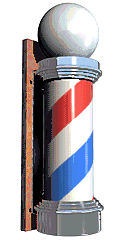Stripe (pattern)
A stripe is a line or band that differs in color or tone from an adjacent area. Stripes are a group of such lines.


Usage and appearance
As a pattern (more than one stripe together), stripes are commonly seen in nature, food, emblems, clothing, and elsewhere.
Two-toned stripes inherently draw one's attention, and as such are used to signal hazards. They are used in road signs, barricade tape, and thresholds.
In nature, as with the zebra, stripes may have developed through natural selection to produce motion dazzle.[1]
Stripes may give appeal to certain sweets like the candy cane.
Fashion
For hundreds of years, stripes have been used in clothing.[2] Striped clothing has frequently had negative symbolism in Western cultures.[2] Historian Michel Pastoureau explores the cultural history of these design decisions in the book, The Devil's Cloth.[2]
Stripes on garment first appeared in the Medieval times. During that era, only prisoners, criminals, clowns, prostitutes, hangmen, etc. were seen wearing a black and white striped garment. However, by the end of the nineteenth century, a new definition of stripes was created by Queen Victoria. The queen dressed her son in a sailor suit during a Royal Yacht boarding event.[3] Stripes were no longer just associated with “someone evil.” Stripes were then connected with words such as “marine” and “sea”. Navy blue and white stripes were adopted by swimmers on their bathing suits. At the beginning of the twentieth century, the stripe fashion became mainstream again. Coco Chanel was inspired by the workers’ uniform during her trip to the French Rivera, and she started to apply the “Navy and White Stripes” into her designs.[3] In the ’50s, movie stars were seen wearing striped shirts through the media. During the ’60s and ’70s, more and more people started to wear striped shirts as the garment was seen as a symbol of rebellion.
See also
References
- "Thesaurus results for STRIPE". www.merriam-webster.com. Archived from the original on 2016-11-26. Retrieved 2018-01-04.
- Pastoureau, Michel (2001). The Devil's Cloth: A History of Stripes and Striped Fabric. Columbia University Press. ISBN 9780231123662.
- Harper & Lewis (2013-08-30). "A Brief History of Stripes in Fashion". harper and lewis vintage. Archived from the original on 2015-04-06. Retrieved 2017-05-22.
External links
![]()